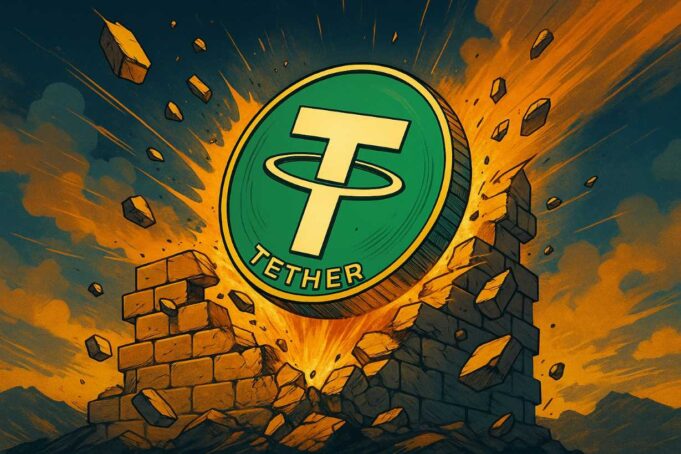The old saying “rumors of my death have been greatly exaggerated” might as well have been coined for Tether (USDT). Long criticized for its offshore structure, opaque reserves, and evasive regulatory strategy, Tether has often been predicted to collapse under pressure. Yet, in 2025, it isn’t just alive, it’s thriving. With over $150 billion in circulation, USDT remains the largest stablecoin by market cap. However, in a world increasingly dominated by regulation, especially with the EU’s MiCA law and the U.S.’s proposed GENIUS Act, Tether is being forced to adapt. From pivoting toward transparency to preparing a U.S.-compliant stablecoin, Tether’s story may not be one of survival but of strategic transformation.
The Global Stablecoin Landscape in 2025
As of mid-2025, Tether commands more than 61% of the global stablecoin market. Its closest rival, Circle’s USDC, stands at around $60 billion in supply. Ripple’s newly launched RLUSD is making headlines but remains a small player with just $300 million in circulation.
Despite fierce competition, Tether continues to dominate crypto trading volumes, especially in emerging markets and on major offshore exchanges like Binance and OKX. While USDC caters to regulated institutions and fintech apps, and RLUSD targets compliant cross-border transactions, USDT remains the liquidity backbone of the global crypto economy.
Why Tether’s USDT Became the Dominant Stablecoin
USDT’s rise began with being first to market in 2014, capturing user trust through convenience, liquidity, and broad availability. Its presence on virtually every major exchange and trading pair cemented its role as the go-to dollar proxy for crypto traders.
Tether’s appeal grew further in countries with restricted access to U.S. dollars. For users in Turkey, Venezuela, and parts of Asia, USDT became a reliable alternative to local currencies. It offers dollar exposure in jurisdictions underserved by traditional banking.
Tether and US Stablecoin Regulation: GENIUS Act and Beyond
The GENIUS Act, which advanced through the U.S. Senate Banking Committee in early 2025, proposes a regulatory framework for “payment stablecoins”. The framework includes requirements for full reserves in cash and short-term Treasuries, monthly disclosures, and annual audits. These rules would apply even to offshore issuers that serve U.S. customers.
>>> Read more: BITCOIN Act Approved, GENIUS Act Hits a Wall
Tether, which has long operated outside U.S. jurisdiction, is now considering a significant shift. In response, the company has announced plans to issue a separate U.S.-compliant stablecoin. This proactive stance suggests Tether is preparing for a world where noncompliance could result in exchange delistings or legal restrictions.
The European Challenge: MiCA and Delistings
Europe’s MiCA regulation, fully enforceable as of March 2025, requires stablecoin issuers to obtain authorization from EU regulators to continue operating in the region. Tether chose not to comply. Instead, it delisted its EUR€ stablecoin and saw USDT removed from major European exchanges like Coinbase Europe.
Rather than restructure USDT, Tether has backed MiCA-compliant entities like StablR and Quantoz. These firms issue stablecoins that meet MiCA standards, allowing Tether to retain indirect access to the European market.
Transparency and Trust: USDT vs USDC vs RLUSD
Tether’s reserve transparency has historically been a point of contention. While Tether now provides monthly attestations via BDO, it has yet to conduct a full public audit. Circle’s USDC, by contrast, undergoes monthly attestations from Deloitte and publishes reserve breakdowns. Ripple’s RLUSD, issued under NYDFS oversight, maintains similarly stringent transparency standards.
The contrast is clear: USDC and RLUSD have leaned into regulatory transparency as a competitive edge. Tether, on the other hand, has taken steps forward but still faces skepticism from some institutional users.
Strategic Shifts: Tether’s Adaptation Playbook
Facing headwinds in the West, Tether has diversified its strategy. Beyond considering a compliant U.S. stablecoin, Tether is expanding into:
- Tokenization Infrastructure: Its Hadron platform supports tokenized assets in MiCA-aligned projects.
- Bitcoin Mining: With a 21.4% stake in Bitdeer, Tether is investing in renewable mining to bolster its crypto ecosystem involvement.
- Reserve Evolution: Tether has reduced risky commercial paper in favor of short-term U.S. Treasuries, enhancing reserve quality.
- Interest Revenue: With large holdings of Treasuries, Tether has posted record profits from interest income in 2024 and 2025.
These moves show a deliberate shift from mere issuer to infrastructure provider, a role that could insulate Tether from future regulatory shocks.
Conclusion: Is USDT at Risk or Repositioning?
Tether is not collapsing; it’s recalibrating. The regulatory tide is rising, and while USDT is losing ground in Europe and faces mounting U.S. pressure, its leadership appears ready to adapt. With a compliant stablecoin in development, strategic investments across the crypto stack, and growing transparency, Tether is betting on evolution rather than retreat.
Its massive market cap, entrenched global usage, and nimble positioning make one thing clear: USDT may no longer be the unchallenged king of stablecoins, but the idea of its demise is, once again, premature. In a regulated future, Tether may not just survive, it might outlast the competition by adapting faster than anyone expects.
Readers’ frequently asked questions
What is the difference between a MiCA-compliant stablecoin and one that is not?
A MiCA-compliant stablecoin is issued by an entity that has received authorization under the European Union’s Markets in Crypto-Assets (MiCA) regulation. This means the issuer must meet strict requirements, including holding sufficient reserves, undergoing regular audits, and operating with regulatory transparency. Licensed exchanges within the EU can legally offer these stablecoins to the public and allow trading in them. ges within the EU. Non-compliant stablecoins, like USDT currently, have not obtained such authorization, and therefore, regulated European exchanges cannot list or promote them to EU customers. This doesn’t necessarily mean they are illegal to hold, but it does limit how and where they can be used.
Why is Tether launching a U.S.-compliant stablecoin instead of making USDT compliant?
Tether appears to be taking a dual-track strategy to meet new U.S. regulations. Instead of overhauling USDT, which is deeply entrenched in global markets and operates under an offshore structure, Tether plans to issue a separate stablecoin specifically designed to comply with U.S. legal standards, including those proposed in the GENIUS Act. This allows Tether to maintain USDT’s current operations in global and less-regulated markets while building a fully regulated alternative for U.S. customers. It’s a way to serve both markets without compromising either product.
If Tether’s USDT is not fully regulated, why is it still the most popular stablecoin?
USDT’s popularity stems from its liquidity, availability, and early-mover advantage. It’s supported by nearly every major crypto exchange and is especially dominant in regions with limited access to traditional banking. Traders and crypto businesses often choose USDT because it is widely accepted, fast to transfer, and deeply integrated into crypto trading pairs. Many users also trust it because it has functioned reliably for nearly a decade, even if it lacks full regulatory oversight. However, its dominance is increasingly being challenged as global regulations tighten and competitors offer more transparent, compliant alternatives.
What Is In It For You? Action Items You Might Want to Consider
Watch Tether’s U.S. Regulatory Moves Closely
If you’re trading or holding USDT on U.S.-based platforms, keep an eye on Tether’s rollout of a U.S.-compliant stablecoin. Regulatory pressure is mounting, and some exchanges may begin to limit USDT access in favor of compliant alternatives. Be prepared to adjust your trading pairs and transfer strategies if new restrictions emerge.
Diversify Your Stablecoin Holdings
Relying solely on USDT may expose you to regional risks, especially in jurisdictions like the EU or the U.S. Consider diversifying into stablecoins like USDC or RLUSD, particularly if you trade on regulated platforms or engage with DeFi protocols that emphasize compliance and audit transparency.
Track Where Liquidity Flows Next
As regulations reshape the stablecoin landscape, market liquidity could shift. Pay attention to volume data across exchanges and blockchains, especially where USDC or RLUSD are gaining traction. Adjust your strategies accordingly to stay ahead of spread changes, slippage risks, or new arbitrage opportunities.











[…] the economy deteriorates, stablecoin dollarization in Bolivia is no longer hypothetical. Tether (USDT) is quietly becoming the functional currency of choice. What began as a workaround is now shaping […]
[…] Tether, the world’s largest stablecoin issuer, faces more than just legal exposure. Its reputation and risk model are now under scrutiny. […]
[…] deal also signals Circle’s intent to challenge USDT’s dominance in the stablecoin market. Leveraging OKX’s massive user base and compliant exchange […]
[…] They will be used for trade, remittance, and e-commerce purposes, which will increase fast. Even Tether, facing regulatory pressure, has adapted and reinvented itself, highlighting the resilience of this […]
[…] >>> Read more: Tether Stablecoin Faces Pressure and Reinvents Itself […]
[…] >>> Read more: Tether Stablecoin Faces Pressure and Reinvents Itself […]